 W
W7,62 ITKK 31 VKT or 7,62 mm VKT anti-aircraft machine gun was the primary anti-aircraft machine gun of the Finnish Army during World War II. The weapon was designed by the Finnish gunsmith Aimo Lahti. 507 weapons were produced in two versions, 7,62 ItKk/31 VKT and an improved 7,62 ItKk/31-40 VKT, between 1933 and 1944.
 W
WThe Besa machine gun was a British version of the Czechoslovak ZB-53 air-cooled, belt-fed machine gun.
 W
WThe Fucile Mitragliatore Breda modello 30 was the standard light machine gun of the Royal Italian Army during World War II.
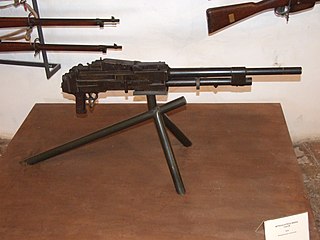 W
WThe Mitragliatrice Breda calibro 8 modello 38 per carri armati was an Italian tank-pattern machine gun used in the Second World War on the Fiat L6/40, the Fiat M11/39 and the Fiat M13/40. It was also adapted as infantry machine gun. The M38 is based upon the Breda M37. The Breda 38 received the German identification code Kampfwagen-Maschinengewehr 350(i).
 W
WThe Mitragliatrice Breda calibro 8 modello 37 was an Italian Medium machine gun produced by Breda and adopted in 1937 by the Royal Italian Army. It was the standard machine gun for the Royal Italian Army during World War II, and continued to be used by the Italian Army after the conflict. The Breda 37 was meant as company/battalion support as compared to the more troublesome Breda 30 meant for squad/platoon support, and proved far more effective in combat, though possessing some of the same problematic features of the Breda 30.
 W
WThe Breda 5C was an Italian medium machine gun, which was adopted by the Royal Italian Army and used in the Second Italo-Ethiopian War and in World War II.
 W
WThe Bren gun was a series of light machine guns (LMG) made by Britain in the 1930s and used in various roles until 1992. While best known for its role as the British and Commonwealth forces' primary infantry LMG in World War II, it was also used in the Korean War and saw service throughout the latter half of the 20th century, including the 1982 Falklands War. Although fitted with a bipod, it could also be mounted on a tripod or be vehicle-mounted.
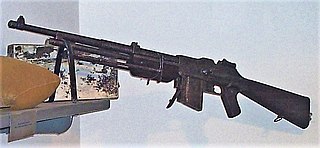 W
WThe Browning wz.1928 is a Polish version of the M1918 BAR. It was a light machine gun used by the Poles in World War II.
 W
WThe Ciężki karabin maszynowy wz. 25 Hotchkiss was a Polish derivative of the Hotchkiss M1914 machine gun, rechambered for 7.92×57mm Mauser ammunition.
 W
WCkm wz. 30 is a Polish-made clone of the American Browning M1917 heavy machine gun. Produced with various modifications such as greater caliber, longer barrel and adjustable sighting device, it was an improved although unlicensed copy of its predecessor, and was the standard machine gun of the Polish Army since 1931.
 W
WThe Darne machine gun is a machine gun of French origin.
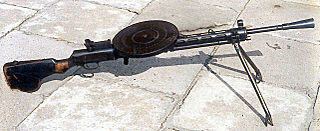 W
WThe Degtyaryov machine gun or DP-27 is a light machine gun firing the 7.62×54mmR cartridge that was primarily used by the Soviet Union, with service trials starting in 1927, followed by general deployment in 1928.
 W
WDS-39 was a Soviet medium machine gun, designed by Vasily Degtyaryov, that was used during the Second World War. The work on the gun's design began in 1930, and it was accepted by the Red Army in September, 1939. About 10,000 were made from 1939 to 1941, but the weapon was not successful in service and its production was discontinued after the German invasion began in June, 1941, with factories converted to produce the older, more reliable PM M1910. which was in turn replaced by the SG-43 Goryunov medium machine gun in 1943.
 W
WThe DShK 1938 is a Soviet heavy machine gun with a V-shaped "butterfly" trigger, firing the 12.7×108mm cartridge. The weapon was also used as a heavy infantry machine gun, in which case it was frequently deployed with a two-wheeled mounting and a single-sheet armour-plate shield. It took its name from the weapons designers Vasily Degtyaryov, who designed the original weapon, and Georgi Shpagin, who improved the cartridge feed mechanism. It is sometimes nicknamed Dushka in Russian-speaking countries, from the abbreviation.
 W
WThe FG 42 is a selective-fire 7.92×57mm Mauser automatic rifle produced in Nazi Germany during World War II. The weapon was developed specifically for the use of the Fallschirmjäger airborne infantry in 1942 and was used in very limited numbers until the end of the war.
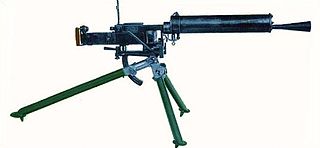 W
WThe Fiat–Revelli Modello 1914 was an Italian water-cooled medium machine gun produced from 1914 to 1918. It was the standard machine-gun of the Italian Army in World War I, and was used in limited numbers into World War II.
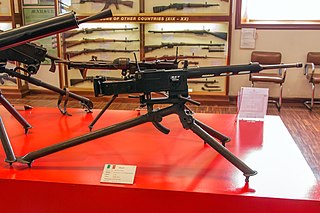 W
WThe Fiat–Revelli 35 was an Italian machine gun, a modified version of the Fiat–Revelli Modello 1914, which had equipped the Italian Army of World War I.
 W
WThe Hotchkiss M1922 was a light machine gun manufactured by Hotchkiss.
 W
WThe 13.2 mm Hotchkiss machine gun was a heavy machine gun designed and manufactured by Hotchkiss et Cie from the late 1920s until World War II and saw service with various nations' forces, including Italy and Japan where the gun was built under license.
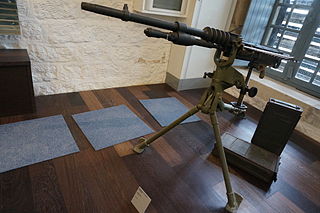 W
WThe Mle 1914 Hotchkiss machine gun chambered for the 8mm Lebel cartridge became the standard machine gun of the French Army during the latter half of World War I. It was manufactured by the French arms company Hotchkiss et Cie, which had been established in the 1860s by American industrialist Benjamin B. Hotchkiss. The gas-actuated Hotchkiss system was first formulated in 1893 by Odkolek von Ujezda and improved into its final form by Hotchkiss armament engineers, American Laurence Benét and his French assistant Henri Mercié.
 W
WKarabin maszynowy wz. 36, also known as Karabin lotniczy uniwersalny wz. 36 was a Polish 7.9 mm calibre aerial machine gun of the 1930s. It was a further modified version of Karabin maszynowy wz. 33, itself a modification of the successful Ckm wz.30 multi-purpose HMG.
 W
WThe Lewis gun is a First World War–era light machine gun. Designed privately in America but not adopted, the design was finalised and mass-produced in the United Kingdom, and widely used by troops of the British Empire during the war. It had a distinctive barrel cooling shroud and top-mounted pan magazine. The Lewis served to the end of the Korean War, and was widely used as an aircraft machine gun during both World Wars, almost always with the cooling shroud removed, as air flow during flight offers sufficient cooling.
 W
WThe M2 machine gun or Browning .50 caliber machine gun is a heavy machine gun designed toward the end of World War I by John Browning. Its design is similar to Browning's earlier M1919 Browning machine gun, which was chambered for the .30-06 cartridge. The M2 uses the much larger and much more powerful .50 BMG cartridge, which was developed alongside and takes its name from the gun itself. It has been referred to as "Ma Deuce", in reference to its M2 nomenclature. The design has had many specific designations; the official US military designation for the current infantry type is Browning Machine Gun, Cal. .50, M2, HB, Flexible. It is effective against infantry, unarmored or lightly armored vehicles and boats, light fortifications, and low-flying aircraft.
 W
WThe Browning Automatic Rifle is a family of American automatic rifles and machine guns used by the United States and numerous other countries during the 20th century. The primary variant of the BAR series was the M1918, chambered for the .30-06 Springfield rifle cartridge and designed by John Browning in 1917 for the American Expeditionary Forces in Europe as a replacement for the French-made Chauchat and M1909 Benét–Mercié machine guns that US forces had previously been issued.
 W
WThe M1919 Browning is a .30 caliber medium machine gun that was widely used during the 20th century, especially during World War II, the Korean War, and the Vietnam War. The M1919 saw service as a light infantry, coaxial, mounted, aircraft, and anti-aircraft machine gun by the U.S. and many other countries.
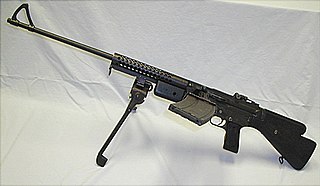 W
WThe M1941 Johnson Light Machine Gun, also known as the Johnson and the Johnny gun, was an American recoil-operated light machine gun designed in the late 1930s by Melvin Johnson. It shared the same operating principle and many parts with the M1941 Johnson rifle and the M1947 Johnson auto carbine.
 W
WThe Madsen is a light machine gun that Julius A. Rasmussen and Theodor Schouboe designed and proposed for adoption by Colonel Vilhelm Herman Oluf Madsen, the Danish Minister of War, and that the Royal Danish Army adopted in 1902. It was the world's first true light machine gun produced in quantity and Madsen was able to sell it in 12 calibres to over 34 countries. The gun saw extensive combat usage for over 100 years, with continued use in limited quantities worldwide into the 2010s. The Madsen was produced by Compagnie Madsen A/S.
 W
WThe Maschinengewehr 08, or MG 08, was the German Army's standard machine gun in World War I and is an adaptation of Hiram S. Maxim's original 1884 Maxim gun. It was produced in a number of variants during the war. The MG 08 served during World War II as a heavy machine gun in many German infantry divisions, although by the end of the war it had mostly been relegated to second-rate fortress units.
 W
WThe MG 13 is a German light machine gun developed by converting the Dreyse Model 1918 heavy water-cooled machine gun into an air-cooled version.
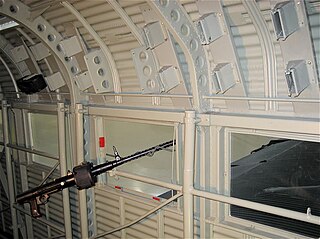 W
WThe MG 15 was a German 7.92 mm machine gun designed specifically as a hand manipulated defensive gun for combat aircraft during the early 1930s. By 1941 it was replaced by other types and found new uses with ground troops.
 W
WThe Maschinengewehr 30, or MG 30 was a German-designed machine gun that saw some service with various armed forces in the 1930s. It was also modified to become the standard German aircraft gun as the MG 15 and MG 17. It is most notable as the design pattern that led to the MG 34 and MG 42, and thus is one of the major ancestors of many of the weapons in service which would later find widespread use into the 21st century.
 W
WThe MG 45 was a machine gun based on the MG 42, which was developed but not fielded in significant numbers by the German Army in World War II.
 W
WThe MG 131 was a German 13 mm caliber machine gun developed in 1938 by Rheinmetall-Borsig and produced from 1940 to 1945. The MG 131 was designed for use at fixed, flexible or turreted, single or twin mountings in Luftwaffe aircraft during World War II.
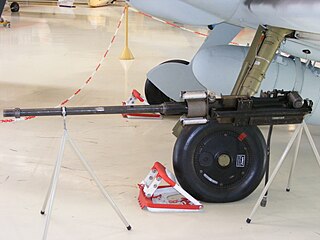 W
WThe MG 151 was a German 15 mm aircraft-mounted autocannon produced by Waffenfabrik Mauser during World War II. Its 20mm variant, the 20 mm MG 151/20 cannon, was widely used on German Luftwaffe fighters, night fighters, fighter-bombers, bombers and ground-attack aircraft. Salvaged guns saw post-war use by other nations.
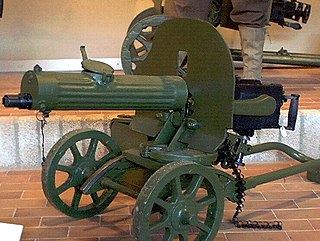 W
WThe Pulemyot Maxima PM1910 is a medium machine gun that was used by the Imperial Russian Army during World War I and the Red Army during the Russian Civil War and World War II. Later the gun saw service in the Korean War and the Vietnam War.
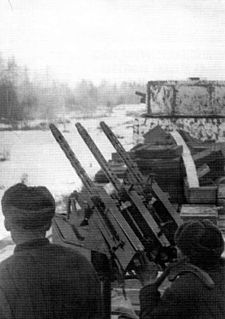 W
WPV-1 is a Soviet air-cooled version of the Russian M1910 Maxim for mounting on aircraft. It was designed between 1926 and 1927. The first prototypes were produced and accepted into service in 1928.
 W
WThe MAC mle 1931 machine gun, was a machine gun used in French tanks of the World War II era, as well as in fortifications such as the Maginot line. It is also sometimes known as the JM Reibel, from Jumelage de mitrailleuses, or Reibel twin-mounted guns and really refers to the specialized twin-mounting frame used in JM cloche cupolas on the Maginot Line fortifications, while MAC mle 1931 refers specifically to the gun. The JM twin-mounts were the standard emplacement for the mle 1931 in fixed fortifications, while tanks and other AFVs received single guns.
 W
WThe Maschinengewehr (Schwarzlose) M. 7, also known as the Schwarzlose MG, is a medium machine-gun, used as a standard issue firearm in the Austro-Hungarian Army throughout World War I. It was utilized by the Dutch, Greek and Hungarian armies during World War II. It was routinely issued to Italian colonial troops, alongside the Mannlicher M1895 rifle.
 W
WThe SG-43 Goryunov was a Soviet medium machine gun that was introduced during the Second World War. It was chambered for the 7.62×54mmR cartridge, and was introduced in 1943 as a replacement for the older M1910 Maxim machine guns. It was mounted on wheeled mounts, tripods and armored vehicles.
 W
WThe T24 machine gun was a prototype reverse engineered copy of the German MG 42 general-purpose machine gun developed during World War II as a possible replacement for the Browning Automatic Rifle and M1919A4 for infantry squads. The T24 was chambered for the .30-06 Springfield cartridge.
 W
WThe type 1 heavy machine gun was a heavy machine gun used by the Imperial Japanese Army during the Second World War starting from 1941.
 W
WThe Type 3 heavy machine gun , also known as the Taishō 14 machine gun, was a Japanese air-cooled heavy machine gun.
 W
WThe Type 11 light machine gun was a light machine gun used by the Imperial Japanese Army in the interwar period and during World War II.
 W
WThe Type 92 Heavy Machine Gun was a Japanese heavy machine gun, related to the Hotchkiss machine gun series. It entered service in 1932 and was the standard Japanese heavy machine gun used during World War II. Known for its reliability, it was used after the war by various forces in East Asia. Designed by Kijiro Nambu and built by Hino Motors and Hitachi, its total production was about 45,000 guns.
 W
WThe Type 92 7.7mm machine gun was developed for aerial use for the Imperial Japanese Navy in 1932. The Type 92 is a light machine gun and not to be confused with the similarly named Type 92 Heavy Machine Gun.
 W
WThe Type 96 light machine gun was a light machine gun used by the Imperial Japanese Army in the interwar period and in World War II. It was first introduced in 1936, and fires the 6.5x50mm Arisaka from 30-round top-mounted magazines. A combination of unimpressive ballistic performance and a lack of reliability caused the Imperial Japanese Army to try to replace the Type 96 with the Type 99 Light Machine Gun, though both saw major usage until the end of the war. Additionally, there were no 6.5mm tracer or armor-piercing ammunition in the inventory.
 W
WThe Type 99 light machine gun was a light machine gun used by the Imperial Japanese Army in World War II. It was similar in design to the earlier Type 96 light machine gun, but designed to fire the new and more powerful 7.7 mm Arisaka cartridge, which improved energy by over 50%. Like the Type 96, the Type 99 traces its history to the ZB vz. 26, which also inspired the Bren light machine gun.
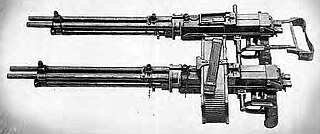 W
WThe Type 100 is a double barrel machine gun of Japanese origin. The weapon is gas operated and fed from an overhead magazine. An example can be seen at the Satria Mandala Museum in Jakarta.
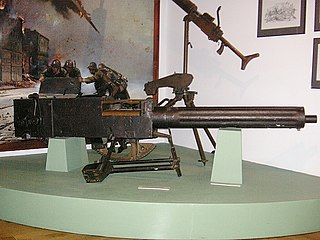 W
WThe Vickers .50 machine gun, also known as the 'Vickers .50' was similar to the .303 inches (7.70 mm) Vickers machine gun but enlarged to use a larger-calibre 0.5-inch (12.7 mm) round. It saw some use in tanks and other fighting vehicles but was more commonly used as a close-in anti-aircraft weapon on Royal Navy and Allied ships, typically in a four-gun mounting. The Vickers fired British .50 Vickers (12.7×81mm) ammunition, not the better known American .50 BMG (12.7×99mm).
 W
WThe Vickers K machine gun, known as the Vickers Gas Operated or Gun, Machine, Vickers G.O. .303-inch in British service, was a rapid-firing machine gun developed and manufactured for use in aircraft by Vickers-Armstrongs. The high rate of fire was needed for the small period of time when the gunner would be able to fire at an attacking aircraft. The weapon was also adopted for land use during World War II.
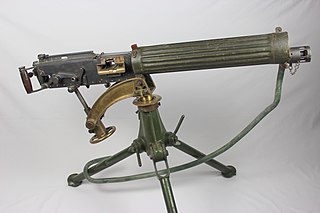 W
WThe Vickers machine gun or Vickers gun is a name primarily used to refer to the water-cooled .303 British (7.7 mm) machine gun produced by Vickers Limited, originally for the British Army. The machine gun typically required a six- to eight-man team to operate: one fired, one fed the ammunition, the rest helped to carry the weapon, its ammunition, and spare parts. Not to be confused with the Maxim machine gun, it was in service from before the First World War until the 1960s, with air-cooled versions of it on many Allied World War I fighter aircraft.
 W
WThe Vickers–Berthier (VB) is a light machine gun that was produced by the British company Vickers-Armstrong. It was adopted by the British Indian Army and saw combat during World War II.
 W
WThe ZB vz. 26 was a Czechoslovak light machine gun developed in the 1920s, which went on to enter service with several countries. It saw its major use during World War II, and spawned the related ZB vz. 27, vz. 30, and vz. 33. The ZB vz. 26 influenced many other light machine gun designs including the British Bren light machine gun and the Japanese Type 96 Light Machine Gun. The ZB-26 is famous for its reliability, simple components, quick-change barrel and ease of manufacturing. This light machine gun in the Czechoslovak army was marked as the LK vz. 26. ZB vz. 26 is incorrect nomenclature because "ZB-26" is a factory designation, while "vzor 26" or "vz. 26" is an army designation.
 W
WThe ZB-53 was a Czechoslovak machine gun. A versatile weapon, it was used both as a squad support weapon, as a mounted machine gun for tanks and other armoured vehicles, and on fixed positions inside Czechoslovak border fortifications. Adopted before the World War II by the armies of Czechoslovakia and Romania, it was also license-built in the United Kingdom as the Besa machine gun. Following the German invasion of Czechoslovakia, large quantities of the weapon were captured by the Wehrmacht and used during the war under the designation of MG 37(t).